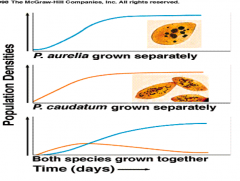![]()
![]()
![]()
Use LEFT and RIGHT arrow keys to navigate between flashcards;
Use UP and DOWN arrow keys to flip the card;
H to show hint;
A reads text to speech;
31 Cards in this Set
- Front
- Back
|
+/+ +/- -/- What do these mean? |
+/+ = both species gain something +/- = one species gains something, while the other loses something -/- = both species lose something |
|
|
Competition is when: |
- multiples species share the same food source - is a -/- outcome, because it is bad for multiple species to have to compete over the same food source - only +/+ when the resource is unlimited, like oxygen |
|
|
Competitive Exclusion is: |
- when one organism hogs resources |
|

What is this an example of? |
- competitive exclusion, because both do well alone - but p. aurella hogs the resources, effectively killing off the other - +/- relationship |
|
|
In the example of a forest containing lizards, what are the fundamental and ecological niches? |
- fundamental niche = the entire forest (they're able to live anywhere within) - ecological niche = a specialized chosen area to live in within the forest that allows them to avoid competition for resources - example: some lizards live in the trees, some on the forest floor |
|
|
How did niches and resource partitioning affect the golden and common spiny mice? |
- when living apart, both are nocturnal - when living together, the common variety is nocturnal while the golden is diurnal |
|
|
What is character displacement? |
- the divergence of characteristics between sympatric population of closely related species - sympatric = speciation with organisms living in the same area |
|
|
What are two predation techniques? |
- lynx with it's chase technique - crocodiles have a lie in wait technique - blends into it's surroundings well |
|
|
What is cryptic coloration? |
- hiding from predators by camouflaging yourself |
|
|
What is aposematic coloration? |
- a warning to predators, usually bright colors and patterns on poisonous prey
- Example: poisonous frogs/lizards and their bright colors |
|
|
What is Batesian mimicry? |
- mimicking something dangerous/harmful when you're harmless - can also be behavior, not just appearance - example: harmless snake mimicking a harmful snakes scale pattern |
|
|
What is Mullerian mimicry? |
- when they prey doesn't taste good, so predators avoid it - example: bees |
|
|
What is an example of batesian behavior mimicking? |
- The Hawkmouth larva looking like the green parrot snake, moving it's head similarly and hissing like the snake does |
|
|
What does the dresser crab do? |
- uses stuff from the surrounding area to camouflage itself by sticking that stuff to itself |
|
|
What type of camouflage does the cuttlefish do? |
- Adaptive camouflage: it somehow changes its appearance based on what is underneath it |
|
|
What do many insects have on their feet? |
- sensors that enable them to distinguish between toxic and non-toxic as well as more nutritious and less nutritious |
|
|
Ectoparacite is: Endoparacite is: |
- ecto = external - endo = internal (tapeworm) |
|
|
What special thing does the spiny head worm do? |
- changes the behavior of its host in order to continue its life cycle - causes its host to move out from protection to be eaten, where the worm continues it life cycle in the next host |
|
|
What are the two types of mutualism? |
- facultative: when all species involved can live independently, but it is more advantageous to live together - obligate: when one species cannot live without the other |
|
|
Commensalism is when: |
- one species benefits while the other species is not harmed or helped - +/0 |
|
|
What is species richness? |
- the number of different species in a community |
|
|
What is relative abundance? |
- the proportion each species represents of all individuals in a community |
|
|
What is the energetic hypothesis? |
- food chains are limited by the inefficiency of energy transfer along the chain - can't have a very long chain because energy transfer is so poor. ~ 10% |
|
|
What is the dynamic stability hypothesis? |
- long food chains are less stable because small fluctuations in population numbers of a producer is magnified as we go up the chain - loss of a producer can cause the entire chain to collapse |
|
|
To be the dominant species is to: |
- be the most abundant or have the greatest biomass - doesn't mean the most important! |
|
|
What is the keystone species? |
- not very abundant in a community - have a strong influence on a communities structure - helps to stabilize and maintain other species in an ecosystem |
|
|
What does a foundation species do? |
- affects the community by causing physical changes in the environment through their behavior or collective biomass - facilitates the establishment of other species |
|
|
Disturbances can be caused by: |
- fire, flood, storms, droughts, overgrazing, ect |
|
|
What is an anthropocentric disturbance? |
- a disturbance caused by humans |
|
|
Secondary succession occurs: |
when an existing community has been cleared by a disturbance that leaves soil behind |
|
|
What is the intermediate disturbance hypothesis? |
that fairly frequent, short-lived, relatively mid-sized disturbances help to drive biodiversity |

